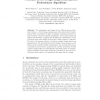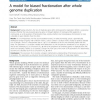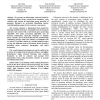38 search results - page 3 / 8 » Variable Length Genomes for Evolutionary Algorithms |
EMO
2005
Springer
14 years 12 days ago
2005
Springer
Abstract. The optimization and design of two different types of photonic devices - a Fibre Bragg Grating and a Microstructured Polymer Optical Fibre is presented in light of multi...
RECOMB
2012
Springer
11 years 9 months ago
2012
Springer
Background: Paralog reduction, the loss of duplicate genes after whole genome duplication (WGD) is a pervasive process. Whether this loss proceeds gene by gene or through deletion...
EC
2006
13 years 6 months ago
2006
The error threshold of replication is an important notion of the quasispecies evolution model; it is a critical mutation rate (error rate) beyond which structures obtained by an e...
BIBE
2007
IEEE
14 years 1 months ago
2007
IEEE
—We present an information retrieval model for combining evidence from concept-based semantics, term statistics, and context for improving search precision of genomics literature...
GECCO
2009
Springer
14 years 1 months ago
2009
Springer
Bloat is a common problem with Evolutionary Algorithms (EAs) that use variable length representation. By creating unnecessarily large individuals it results in longer EA runtimes ...



